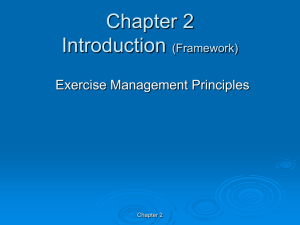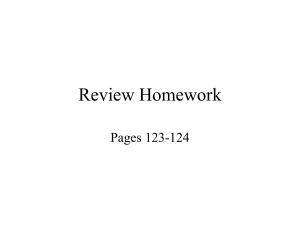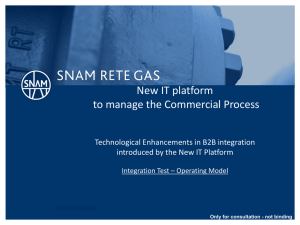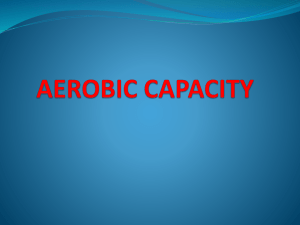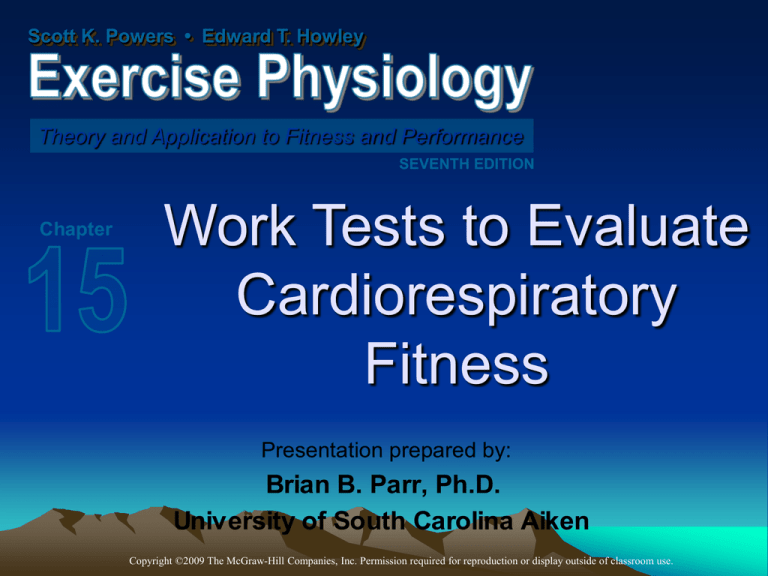
Scott K. Powers • Edward T. Howley
Theory and Application to Fitness and Performance
SEVENTH EDITION
Chapter
Work Tests to Evaluate
Cardiorespiratory
Fitness
Presentation prepared by:
Brian B. Parr, Ph.D.
University of South Carolina Aiken
Copyright ©2009 The McGraw-Hill Companies, Inc. Permission required for reproduction or display outside of classroom use.
Chapter 15
Objectives
1. Identify the sequence of steps in the
procedures for evaluating
cardiorespiratory fitness (CRF).
2. Describe one maximal and one
submaximal field test used to evaluate
CRF.
3. Explain the rationale underlying the use of
distance runs as estimates of CRF.
4. Identify the common measures taken
during a graded exercise test (GXT).
Copyright ©2009 The McGraw-Hill Companies, Inc. All Rights Reserved.
Chapter 15
Objectives
6. List three criteria for having achieved VO2
max.
7. Estimate VO2 max from the last stage of a
GXT and list the concerns about the
protocol that may affect that estimate.
8. Estimate VO2 max by extrapolating the
HR/VO2 relationship to the person’s ageadjusted maximal HR.
9. Describe the problems with the
assumptions made in the extrapolation
Copyright ©2009 The McGraw-Hill Companies, Inc. All Rights Reserved.
Chapter 15
Objectives
10.Identify criteria used to terminate the
GXT.
11.Explain why there are so many different
GXT protocols and why the rate of
progression through the test is of concern.
12.Describe the YMCA’s procedure to set
the rate of progression on a cycle
ergometer test.
13.Estimate VO2 max with the Åstrand and
Ryhming nomogram given a data set for
Copyright ©2009 The McGraw-Hill Companies, Inc. All Rights Reserved.
Chapter 15
Outline
Testing
Procedures
Screening
Resting and Exercise
Measures
Field Tests for
Measuring CRF
Maximal Run Tests
Walk Tests
Canadian Home
Fitness Test
Graded Exercise
Tests:
Measurements
Heart Rate
Blood Pressure
ECG
Rating of Perceived
Exertion
Termination Criteria
VO2 max
Estimation of VO2 max
from Last Work Rate
Estimation of VO2 max
from Submaximal
Heart Rate Response
Graded Exercise
Test: Protocols
Treadmill
Cycle Ergometer
Step Test
Copyright ©2009 The McGraw-Hill Companies, Inc. All Rights Reserved.
Chapter 15
Testing Procedures
Screening
• Signing consent form
• Physical Activity Readiness
Questionnaire (PAR-Q)
• PARmed–X
– Highlights absolute and relative
contraindications for exercise
• ACSM Risk Stratification
– Low risk
• Men <45 yr, women <55 yr, asymptomatic, ≤1 risk
factor
– Moderate risk
Copyright ©2009 The McGraw-Hill Companies, Inc. All Rights Reserved.
Chapter 15
Testing Procedures
Decision Tree in the Evaluation
of Cardiorespiratory Fitness
Copyright ©2009 The McGraw-Hill Companies, Inc. All Rights Reserved.
Figure 15.1
Chapter 15
Testing Procedures
PAR-Q
Copyright ©2009 The McGraw-Hill Companies, Inc. All Rights Reserved.
Figure 15.2
Chapter 15
Testing Procedures
Resting and Exercise Measures
• Resting measures
– Heart rate and blood pressure
– Cholesterol
– ECG
• Exercise measures (GXT or field test)
– Heart rate
– Blood pressure
– ECG
– Symptoms
Copyright ©2009 The McGraw-Hill Companies, Inc. All Rights Reserved.
Chapter 15
Testing Procedures
In Summary
The steps to follow before conducting
an exercise test
to evaluate CRF include:
a. signing of a consent form,
b. screening,
c. obtaining
resting HR and BP as well as
cholesterol and ECG measures.
Copyright ©2009 The McGraw-Hill Companies, Inc. All Rights Reserved.
Chapter 15
Field Tests for Estimating CRF
Field Tests for Estimating
Cardiorespiratory Fitness
• Use natural activities
– Walking, running, or stepping
• Can test large numbers of people at low
cost
• Physiological responses may be difficult to
measure
• Motivation plays an important role in test
results
Copyright ©2009 The McGraw-Hill Companies, Inc. All Rights Reserved.
Chapter 15
Field Tests for Estimating CRF
Maximal Run Tests
• Measure how far a person can run in a set
time or how fast they can run a set
distance
– Cooper’s 12-minute run and 1.5-mile run
• For adults
– AAPHERD’s 1-mile run/walk and PACER test
• For children
• VO2 max estimates based on the linear
relationship between running speed and
oxygen cost of running
Copyright ©2009 The McGraw-Hill Companies, Inc. All Rights Reserved.
Chapter 15
Field Tests for Estimating CRF
Estimating VO2 From Walk/Run
Tests
• Calculating VO2 from running speed
VO2 = 0.2 ml•kg–1•min–1 per m•min–1 + 3.5 ml•kg–1•min–1
• Calculating–1VO2–1 from walking
speed
–1
–1
–1
VO2 = 0.1 ml•kg •min per m•min + 3.5 ml•kg •min
Copyright ©2009 The McGraw-Hill Companies, Inc. All Rights Reserved.
Chapter 15
A Closer Look 15.1
Field Tests for Estimating CRF
Progressive Aerobic
Cardiovascular Endurance Run
(PACER)
• Used in school
children
– Part of FITNESSGRAM testing battery
• 20-meter shuttle run
• Initial speed is 5.3 mph
– Increases 0.3 mph with each level
• Test terminated when student cannot
keep up
– Number of laps used to determine aerobic
fitness
Copyright ©2009 The McGraw-Hill Companies, Inc. All Rights Reserved.
Chapter 15
Field Tests for Estimating CRF
Aerobic Fitness Classifications
Copyright ©2009 The McGraw-Hill Companies, Inc. All Rights Reserved.
Chapter 15
•
A Closer Look 15.2
Field Tests for Estimating CRF
Cardiovascular Fitness
Standards
for Children
Normative standards
– Percentile scores (75th percentile)
• Criterion-reference standards
– Describe the minimum level of fitness
consistent with good health
– Example:
• VO2 max standards set at 42 ml•kg–1•min–1 for
boys (5–17 y)
– Tests designed to translate criterion values
into performance outcomes
Copyright ©2009 The McGraw-Hill Companies, Inc. All Rights Reserved.
Chapter 15
Field Tests for Estimating CRF
Walk Tests
• One-mile walk test requires simple
measurements
• VO2 max is based on:
– Age (years),
weight
(pounds), sex (0 for
–1
–1
VO2 (ml•kg •min ) = 132.853 – 0.0769 (wt) – 0.3877
female,
1 for
male),
time
(min),
and
HR
(age) + 6.315
(sex)
– 3.2649
(time)
– 0.1565
(HR)
(beats/min)
• As fitness improves, HR and/or time will
Copyright ©2009 The McGraw-Hill Companies, Inc. All Rights Reserved.
Chapter 15
Field Tests for Estimating CRF
Canadian Home Fitness Test
• Uses 8-inch steps to evaluate
cardiorespiratory fitness
• Measure HR after 3 minutes of stepping
– Stop if it exceeds maximum allowable HR
based
on age
– Continue for another 3 minutes if it is below
maximum allowable HR
– Fitness level is based on post-exercise HR
Copyright ©2009 The McGraw-Hill Companies, Inc. All Rights Reserved.
Chapter 15
Field Tests for Estimating CRF
Fitness Evaluation from the
Canadian Home Fitness Test
Copyright ©2009 The McGraw-Hill Companies, Inc. All Rights Reserved.
Chapter 15
Field Tests for Estimating CRF
In Summary
Field tests for CRF use natural activities such as
walking, running, and stepping in which large
numbers of people can be tested at low cost.
However, for some, physiological responses are
difficult to measure, and motivation plays an
important role in the outcome.
VO2 max estimates from all-out run tests are based
on the linear relationship between running speed
and the oxygen cost of running.
The Canadian Home Fitness Test is a step test that
uses conventional 8-inch steps to evaluate
cardiorespiratory fitness.
Copyright ©2009 The McGraw-Hill Companies, Inc. All Rights Reserved.
Chapter 15
Graded Exercise Tests: Measurements
Graded Exercise Tests
• Cardiorespiratory fitness measured using:
– Treadmill
– Cycle ergometer
– Stepping bench
• Incremental tests
– Work rate increases every 2–3 minutes
• until predetermined endpoint is reached
• Tests can be maximal or submaximal
Copyright ©2009 The McGraw-Hill Companies, Inc. All Rights Reserved.
Chapter 15
Graded Exercise Tests: Measurements
Heart Rate
• Measured by
– Palpation
• Carotid or radial artery
– Stethoscope
• On chest wall
– ECG
• Heart rate displayed on monitor
• Measured during exercise or in recovery
– Recovery HR should be measured within first
15 seconds
Copyright ©2009 The McGraw-Hill Companies, Inc. All Rights Reserved.
Chapter 15
Graded Exercise Tests: Measurements
Blood Pressure
• By auscultation
• During walking or cycling exercise
– Subject should not be holding handlebar
• Systolic BP
– First Korotkoff sound
• Diastolic BP
– Fourth Korotkoff sound
• Change in tone or muffling
Copyright ©2009 The McGraw-Hill Companies, Inc. All Rights Reserved.
Chapter 15
Graded Exercise Tests: Measurements
ECG
• Double product
– Product of HR and systolic BP
– Estimate of myocardial O2 demand
• Arrhythmias
– Irregularities in normal electrical rhythm
• Atrial fibrillation
• Premature junctional and ventricular contractions
• Conduction disturbances
– Depolarization is slowed or blocked
• First-degree AV block or bundle branch block
• Myocardial ischemia
– Inadequate perfusion of myocardium
– Angina pectoris
• Symptom of ischemia
– ST segment depression
• Sign of ischemia
Copyright ©2009 The McGraw-Hill Companies, Inc. All Rights Reserved.
Chapter 15
Graded Exercise Tests: Measurements
Three Types of ST Segment
Depression
Copyright ©2009 The McGraw-Hill Companies, Inc. All Rights Reserved.
Figure 15.3
Chapter 15
Graded Exercise Tests: Measurements
Rating of Perceived Exertion (RPE)
• Original 6–20 scale and revised scale (0–10)
• Indicator of subjective effort
– Way to track progress through a GXT
– Can be used to prescribe exercise
• Instructions
“During the exercise test we want you to pay close attention to
how hard you feel the exercise work rate is. This feeling should
reflect your total amount of exertion and fatigue, combining all
sensations and feelings of physical stress, effort, and fatigue.
Don’t concern yourself with any one factor such as leg pain,
shortness of breath, or exercise intensity, but try to concentrate
on your total, inner feeling of exertion. Try not to underestimate
or overestimate your feeling of exertion; be as accurate as you
can.”
Copyright ©2009 The McGraw-Hill Companies, Inc. All Rights Reserved.
Chapter 15
Graded Exercise Tests: Measurements
Original and Revised RPE
Scales
Copyright ©2009 The McGraw-Hill Companies, Inc. All Rights Reserved.
Chapter 15
Graded Exercise Tests: Measurements
Termination Criteria
• Include signs and symptoms
• Depend on:
– Population being tested
– Purpose of the test
• ACSM’s Guidelines for Exercise Testing
and Prescription
– Appropriate for nondiagnostic GXTs
Copyright ©2009 The McGraw-Hill Companies, Inc. All Rights Reserved.
Chapter 15
Graded Exercise Tests: Measurements
GXT Termination Criteria
Copyright ©2009 The McGraw-Hill Companies, Inc. All Rights Reserved.
Chapter 15
Graded Exercise Tests: Measurements
In Summary
Typical measurements obtained during
a graded exercise test include heart
rate, blood pressure, ECG, and rating of
perceived exertion.
Specific signs (e.g., fall in systolic
pressure with an increase in work rate)
and symptoms (e.g., dizziness) are
used to stop GXT.
Copyright ©2009 The McGraw-Hill Companies, Inc. All Rights Reserved.
Chapter 15
VO2 Max
VO2 Max
• The gold standard measure of
cardiorespiratory fitness
– Very reproducible on same work instrument
• Depends on work instrument
– Highest on treadmill
• Walking ~6% lower than running
– Lower (~5–11%) on cycle ergometer
– Arm ergometer values 70% of leg ergometer
• VO2 max vs. VO2 peak
Copyright ©2009 The McGraw-Hill Companies, Inc. All Rights Reserved.
Chapter 15
VO2 Max
Criteria for Achieving VO2 Max
• Leveling off of VO2 with higher work rate
<150 ml•min–1 or <2.1 ml•kg–1•min–1
• Post-exercise blood lactate >8 mmoles•L–1
• R >1.15
• HR within 10 beats•min–1 or age-predicted
maximal HR
– Usefulness has been questioned
• Should not expect subjects to meet all
criteria
Copyright ©2009 The McGraw-Hill Companies, Inc. All Rights Reserved.
Chapter 15
VO2 Max
A Closer Look 15.3
VO2 Max and the Plateau—Needed or Not?
• Not all subjects achieve a plateau in VO2
– Led to development of secondary criteria
• Several studies have demonstrated that a
plateau is not needed for a “true” VO2
max
– Highest VO2 measured during incremental
exercise test not different from VO2 during
subsequent test at higher work rate
Copyright ©2009 The McGraw-Hill Companies, Inc. All Rights Reserved.
Chapter 15
Estimation of VO2 Max From Last
Work Rate
VO2 Max
• Direct measurement of VO2 max is often
not practical
– Complex and costly procedures
• Can use equations to calculate estimated
VO2 max from last stage of GXT
– Must allow time for subject to reach steady
state in each stage
Copyright ©2009 The McGraw-Hill Companies, Inc. All Rights Reserved.
Chapter 15
VO2 Max
A Closer Look 15.4
Error in Estimating VO2 max
• Equations developed by actually measuring VO2 max in
large numbers of subjects
• Standard error (SE)
– How far off the predicted VO2 max is from actual
value
• 1 SE describes 68% of estimates
– VO2 max estimated from last stage of maximal test
• SE = 3 ml•kg–1•min–1
– VO2 max estimated from HR in submaximal test
• SE = 4–5 ml•kg–1•min–1
– VO2 max estimated from one-mile walk or 12-minute
run
• SE = 5 ml•kg–1•min–1
Copyright ©2009 The McGraw-Hill Companies, Inc. All Rights Reserved.
Chapter 15
VO2 Max
Estimation of VO2 Max From Submaximal
Heart Rate Response
• Measure HR at several submaximal work rates
– Up to 70–85% predicted maximal HR
• Extrapolate submaximal HR to estimate VO2 max
– A line is drawn through the HR points measured during the test
and extrapolated to the age-adjusted estimate of maximal HR
– Another line is dropped down from that point to the x-axis, and
the VO2 max is identified
• Problems
– SD of Age-predicted maximal HR is ±11 beats•min–1
• Can result in over- or underestimation of VO2 max
– Other factors affect submaximal HR response
• e.g., dehydration, temperature, medications
Copyright ©2009 The McGraw-Hill Companies, Inc. All Rights Reserved.
Chapter 15
VO2 Max
Estimation of VO2 max From Submaximal
Cycle Ergometer Test
Copyright ©2009 The McGraw-Hill Companies, Inc. All Rights Reserved.
Figure 15.4
Chapter 15
VO2 Max
In Summary
The measurement of VO2 max is the gold standard measure of
cardiorespiratory fitness.
VO2 max can be estimated based on the final work rate
achieved in a graded exercise test.
VO2 max can be estimated from heart rate responses to
submaximal exercise by extrapolating the relationship to the
subject’s age-adjusted estimate of maximal heart rate. Careful
attention to environmental factors that can affect the heart rate
response to submaximal exercise is an important aspect of the
procedures for these tests.
Copyright ©2009 The McGraw-Hill Companies, Inc. All Rights Reserved.
Chapter 15
Graded Exercise Test: Protocols
Graded Exercise Test: Protocols
• Consideration of the population tested
– Submaximal vs. maximal test
– Starting work rate
– Rate of change of work rate
– Mode of exercise
• Treadmill
• Cycle ergometer
• Step test
• Subjects must follow instructions carefully
• Environmental conditions must be controlled
– Temperature and humidity
Copyright ©2009 The McGraw-Hill Companies, Inc. All Rights Reserved.
Chapter 15
Graded Exercise Test: Protocols
Treadmill
• Use natural activities
– Walking and running
• Can accommodate a wide range of subjects
– Least fit to most fit
• Involve increasing speed and/or grade
• Estimating VO2 max
– Usually based on extrapolating submaximal HR
• Test terminated at 85% age-predicted maximal HR
– Could also be a single-stage test
Copyright ©2009 The McGraw-Hill Companies, Inc. All Rights Reserved.
Chapter 15
Graded Exercise Test: Protocols
Treadmill GXT Protocols
Copyright ©2009 The McGraw-Hill Companies, Inc. All Rights Reserved.
Chapter 15
Graded Exercise Test: Protocols
Estimation of VO2 Max from Submaximal
Treadmill Test
Copyright ©2009 The McGraw-Hill Companies, Inc. All Rights Reserved.
Figure 15.5
Chapter 15
Graded Exercise Test: Protocols
Cycle Ergometer
• Body weight is supported
– Can accommodate subjects with orthopedic
limitations
• Work rate depends on resistance and pedal rate
– Generally, pedal rate is maintained and resistance is
increased
• Estimating VO2 max
– Based on extrapolating submaximal HR during
incremental test
• YMCA protocol
– From a single-stage, 6-minute test
• Åstrand and Ryhming nomogram
Copyright ©2009 The McGraw-Hill Companies, Inc. All Rights Reserved.
Chapter 15
Graded Exercise Test: Protocols
YMCA
Protocol
Copyright ©2009 The McGraw-Hill Companies, Inc. All Rights Reserved.
Figure 15.6
Chapter 15
Graded Exercise Test: Protocols
Example of the YMCA Protocol
Used to Estimate VO2 max
Copyright ©2009 The McGraw-Hill Companies, Inc. All Rights Reserved.
Figure 15.7
Chapter 15
Graded Exercise Test: Protocols
Nomogram for
Estimation of
VO2 max from
Submaximal HR
Copyright ©2009 The McGraw-Hill Companies, Inc. All Rights Reserved.
Figure 15.8
Chapter 15
Graded Exercise Test: Protocols
Step Test
• Simple, inexpensive equipment
• Protocols differ in:
– Step height
– Step rate
• Estimating VO2 max
– Based on extrapolating submaximal HR
– Can also use Åstrand and Ryhming
nomogram
Copyright ©2009 The McGraw-Hill Companies, Inc. All Rights Reserved.
Chapter 15
Graded Exercise Test: Protocols
Predicting VO2 Max from Submaximal Step
Test
Copyright ©2009 The McGraw-Hill Companies, Inc. All Rights Reserved.
Figure 15.9
Chapter 15
Graded Exercise Test: Protocols
In Summary
VO2 max can be estimated with the
extrapolation procedure using the
treadmill, cycle ergometer, or step.
The subject must follow directions
carefully and environmental conditions
must be controlled if the estimate of
VO2 max is to be reasonable and
reproducible.
Copyright ©2009 The McGraw-Hill Companies, Inc. All Rights Reserved.




